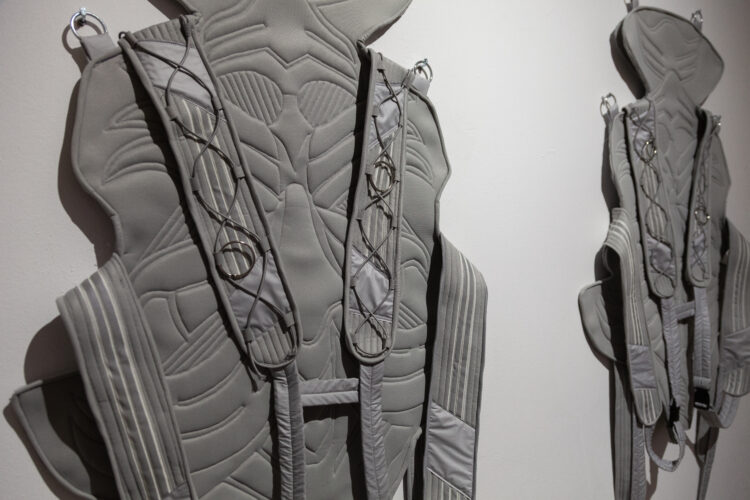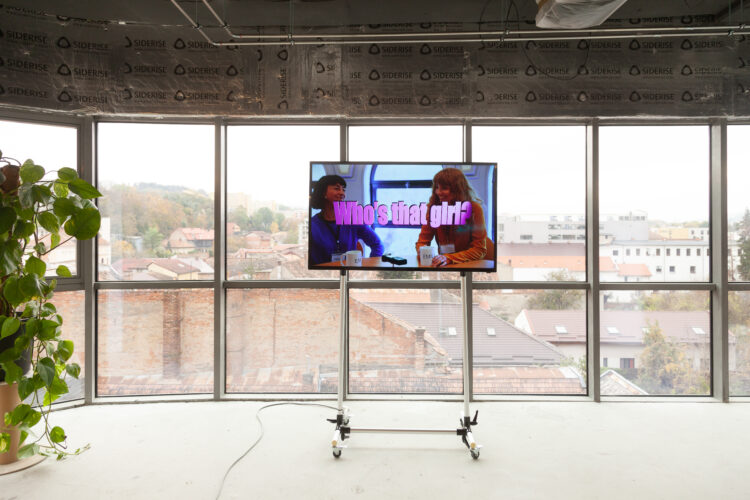“…it is called Null Island, and you cannot travel there.” Yet, we find ourselves closer to fictions in our everyday life than we usually like to admit. As you reach your hand to search for the shortest way home or map your memories, tagging places and friends, you are about to pass through one: An “objective untrue” – it’s how science calls Null Island. A functional placeholder, like many others used in approximating reality, marks the meeting point between the Equatorial line – of scientific calculation – and the Meridian, in all its history of violence, which still sets the order of our time. From here, GPS systems ground their calculations, set algorithms of geolocation, and drive us safely home.[1]
Technology theorist Yvonne Förster suggested storytelling to be one of the earliest ways for the virtual passing into the real,[2] just as the digital spills over today. As its many arrangements and habits embroider us, it is through them that we get to perceive and sense the world. Fictions of Tech and Life, the curatorial project that set sail last year, tended to fictions as they brush on our skin and everyday interactions. To set in motion such an idea, one thinks about narrowing it down, to make it graspable or easily defined. Still, what if you are to move towards an opening and, instead, as Vilém Flusser so cunningly said about writing, let an idea lay as many eggs as possible?[3] What fictions do we dress ourselves in, work on, or use to question one-sided stories? What happens when we move with the principle of our screens – of unfolding worlds within worlds, affectively approximating what we call “the” world?
Since starting a conversation is never an easy task, a point of bonding was needed, one that moved from the warmth of the body onwards and let many threads unfold. Technology has made us dream the dream of expansion; but into what? As a superfluous body came to inhabit our imaginaries, floating on the surface of our screens, travelling through chunks of data, all measured up, how are we to navigate the many fictions holding on to it? What are we touching on, and what touches us back?
At the Centre of the World There is a Fiction… at the centre of the body, we do not know …
Fashion, design, and technology make for one of those entangled bonds that see the body as a battleground and a sort of hyperobject, a material that can be easily framed and “profiled” (from gender to cyber-signature or even DNA). Yet stretching the conventional sense of the “wrappings of the body” – of our everyday prosthetics – could give a glimpse into other dimensions of the fictions we live our lives in. And as we do, there’s hope as well for nurturing encounters and opening spaces for vulnerability and sensual forms of connectedness that are not only human.
Hidden in the back of a concrete garden, the likes of many others populating the city of Cluj-Napoca, our first exhibition of the series manifested as a threshold where the everyday and the speculative temporarily met. In-between, artists made room for an atmospheric feel for other stories. As Taietzel Ticălos’s video work, The Pervasive Sense of Passage, shuffled undisclosed tarot cards within a wired world, the space got filled by its mesmerizing voice as an incantation or demand to “show me what I need to see.” Spirituality became a tool for making sense of our techno-culture, as her 3D reinterpretations of the 22 Major Arcanas inserted an ambiguous and personal sense of locality, referencing recent politics, tropes of living in a former socialist country and the subtle question of “what about the world today.” Where the propensity of rationalising oneself has shattered, relatedness becomes key, as in the unkind cards, the present, pastness, and future merge. Further on, Giulia Crețulescu’s padded structures laid out the vulnerability of the body and our protective prosthetics that, so easily incorporated and harnessed around us, became almost invisible in their function, ideologies, and the shaping of our habits. Riding a Speeding Vehicle Under Hypnosis referenced ergonomics and the “camouflage of comfort,” but summoned our sensing body through texturality. In a mirroring movement, Prosper Centre’s Memory Armour, floating against Sahej Rahal’s pink-drop landscape screen, contoured a soft sensual exoskeleton, made from a traditional coverlet. Memory became an emotional tool for navigating the current world, and, in a double move, alluded to our belongings as “living things” with a life of their own – as so many are already imbued with a pre-existent history. Extending through the gaps of the armour and the space itself, Rahal’s Antraal / Shrota offered a glimpse into a world where the anthropocentric vanished and, instead, biomes run loose. Like a virtual anthropologist, an AI-controlled camera registered the unwritten choreography of an ecosystem where its inhabitants reacted to sounds, both from the IRL and to the ones they produced themselves. And then, in the corner of one’s eyes, Mitra Wakil & Fabian Hesse made room for Organic Probabilities. In a speculative play, they asked if we could envision ourselves differently through non-human perspectives. By applying predictive algorithms used to study plant growth they generated 3D sculptures, and distorted renderings of the artists’ bodies themselves. In a video loop, the body became an artefact, floating in an indefinite space, while revealing a machinic vision whose registering of noise, errors, and other information resulted in tragicomical blobs.
As the sounds reverberated, the biomes continued to find their living potential, while cards were shuffling past and future alike on versions of bodies to dress and cohabitate with. From the warmth of our skin and our emotional appendages, sometimes, you just have to stay on the threshold and see where an “otherwise” can carry you.
Moving with the body beyond its shell, the following shows expanded on the fictions building up the world around us. Threading the needle, what fictions make up the fabric of the workplace? What is lost and what is missed? The 19th century economist Kari Polanyi already noted that work and money are “fictional commodities,” because they aren’t produced but they are treated “as if” they were in order to be sold.[4] Fast forward to the current corporate culture, and the promise of “family and friendship” is used to grant workers a sense of belonging while keeping them under surveillance. And as labour transitioned to a new work-from-home routine, we occupied the floor of a former bank headquarters, a space in-waiting of offices. A non-place, whose illusory emptiness we took to inhabit. Together with 15 artists, writers, and workers, we looked at the watercooler momement gossip and the subversive use of copy-machine as nostalgic disruptors; treating “work as play” (as the mantra of our corporate times goes) with irony, fun memes, incantations for unionizing, depressive thoughts wrapped in jokes, and the much more direct fuck-yous. Among them, Smaranda Ursuleanu’s feminist performance coated in pink shades pointed towards the 9-5 woman at desk duty and the constant bodily sexualization and beauty requirements. In an equally humorous take, Naomi Fitzsimmons video Emily took the “woman at the office” trope and talked about the experience of temp-work within an all-male financial recruitment firm in the city of London. We found refuge gossiping once more, out of spite, in Cristi Grecu’s workshop on the many working fictions found in the glorification of work.
And as we leave work behind, is the comfort of our homes an actual relief when the screens we stare into are yet again just another kind of labour to feed cybernetic flow (of big data)? In the intimate setting of our studio, with In Parallel Universes Different Things can Happen we let other conversations arise, as bubbles of interspaces, which mixed nonetheless nostalgic vibes with critical stances. Like in Andrea Medar and Mălina Ionescu’s cryptographic detournement of Facebook, turning its now public space into a private unaccessible one by the child-like game of “coding” quite literally into messages, and ultimately asking where does the private communication still reside. Megan Dominescu’s comfy retreat in fiction, through weavy materials, functioned as a projection screen for our relationship with non-speaking companions and the “wonderous world” they might have lost. But as fictions of nostalgia unfold, they also become something else – economic underlayers. Famous Female Artist’s retro comical stories about the zeroes we lost on our banknotes draw on hyperinflation and the effects of economic speculation; a subject taken further by Cătălina Bucos’ intricate video Transfiguration, connecting the pyramid schemes that locally characterized the ’90s financial speculation boom, to occult energetic pyramids and current politics. As it seems that might be no relief, maybe the trick is to just let these clashing fictions happen, and in their strangeness recognise reality as something generated, bound by encounters[5] in the everyday, no less political, social, and cutting-through.
As fictions live and grow within our lives, they take matter and shape experiences – from bringing us into despair to instilling a sense of hope. Then, to thread them wisely. As Donna Haraway beautifully pointed out: “it matters what stories we tell to tell other stories with, what knots knot knots” for how we carry ourselves and others, humans and non-humans alike.
At the Center of the World There is a Fiction/ 25.09 – 03.10.2020 / Aici Acolo Pop Up Gallery / Artists: Giulia Crețulescu, Prosper Center, Sahej Rahal, Taietzel Ticălos, Mitra Wakil & Fabian Hesse / part of the extended curatorial project Fictions of Tech & Life – Expozițiile Aici Acolo.
[1] Jon K. Show & Theo Reeves-Evision, Fiction as Method, 2017.
[2] Yvonne Förster, “From Digital Skin to Digital Flesh: Understanding Technology Through Fashion,” in Popular Inquiry, Vol.1, 2018
[3] Vilém Flusser to his friend Felix Phillip Ingold, May 22, 1984, In Vilém Flusser: An Introduction, (eds) Anke Finger, Rainer Guldin, Gustavo Bernardo Krause.
[4] Karl Polanyi, The Great Transformation (1944) cit. Fiction as Method, 2017, pp. 21-22.
[5] After Vilém Flusser, “On Fiction,” in Design Fiction EP / Vol. 2, 2016.
POSTED BY
Edith Lazar & Flaviu Rogojan
Edith Lázár and Flaviu Rogojan are two thirds of the Aici Acolo collective.Edith Lázár is an independent researcher (fashion theory), curator, and art writer based in Cluj-Napoca, Romania. She...
www.aiciacolo.ro/










Comments are closed here.